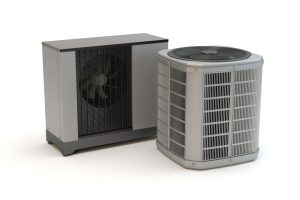Making the change from using a standard central air conditioning system to a heat pump isn’t difficult. Heat pumps operate in a similar way to air conditioners and contain most of the same components to do the job. It’s not difficult for installers to remove a standard AC and put a heat pump in its place. Externally, they look similar, so most non-experts can’t tell them apart.
Of course, they do have differences, because the heat pump can do what the AC cannot—work in heating mode as well as cooling mode. Because we have extensive experience with heat pump installation and heat pump repair in Glenwood, GA, we know all about the components of a heat pump that allow it to do these two jobs. We’re going to list the most important of these parts below to help you get a better sense of what your heat pump does—or what you’ll want from the heat pump you’re planning to install.
The Reversing Valve
The reversing valve is one of the key components that sets a heat pump apart from a standard air conditioner. This valve allows the heat pump to reverse the flow of refrigerant, which is how it is able to switch between heating and cooling modes. In cooling mode, the refrigerant absorbs heat from inside your home and releases it outside. In heating mode, the process reverses: the refrigerant absorbs heat from the outside air and releases it inside your home.
Refrigerant Charge and Flow Control
Proper refrigerant charge and flow control are crucial for the efficient operation of a heat pump. The refrigerant is the medium that carries heat either into or out of your home, depending on the mode of operation. Heat pumps use a thermostatic expansion valve (TXV) or an electronic expansion valve (EEV) to regulate the flow of refrigerant, neither of which is necessary in an air conditioner. Maintaining the correct refrigerant charge is essential for a heat pump to operate effectively.
Defrost Controls
Heat pumps have to deal with the occasional challenge of frost build-up on the outdoor coil during the heating mode because of cold weather. To handle this, they’re equipped with defrost controls that periodically switch the heat pump into cooling mode to melt any frost or ice that has accumulated. This process ensures that the heat pump continues to operate efficiently and prevents damage to the system. The defrost cycle is controlled to minimize the impact on indoor comfort and energy efficiency.
Suction Line Accumulator
The suction line accumulator is another component unique to heat pumps. Its function is to prevent liquid refrigerant from entering the compressor. During the defrost cycle, or when the heat pump is operating in heating mode, liquid refrigerant might flow the wrong direction and make its way back to the compressor. This can potentially wreck the compressor! The accumulator captures this liquid refrigerant, ensuring that only vapor enters the compressor.
Heat pumps are complex devices, and you should never hesitate to seek the expertise and skills of our technicians when you have concerns about your heat pump or are interested in switching to one. We are here to see you have the comfort you need all twelve months of the year.


